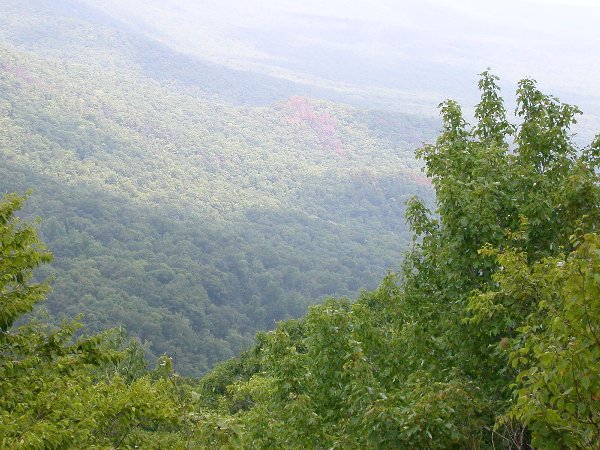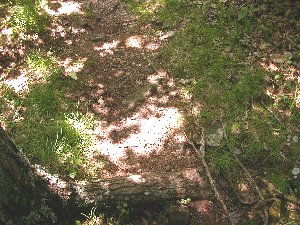
View from Warspur Trail, Giles County
Virginia has two national forests, the George Washington National Forest and Jefferson National Forest. Both are located in the western mountains of the state.

View from Warspur Trail, Giles County
The Federal Government acquired these lands under the Weeks Act of 1911. At that time, the role of the Federal government was seen as much more limited than today after two world wars, the Great Depression, the Cold War, and various decisions of the Congress to assert Federal responsibilities and approval by the Supreme Court. The authority of the Federal government to purchase private property was not as generally accepted as today.
The Weeks Act clearly tied the creation of these forests to the Federal responsibility for interstate commerce, by identifying the land acquisition as necessary to protect headwaters of navigable rivers. The headwaters were far from the international ports east of the Fall Line, but managing the runoff from the headwaters would help, along with dredging, to maintain the depth of the commercial shipping channels.
To further that mission, the US Forest Service is still acquiring land. In 2019, it purchased a 4,665-acre tract in Botetourt County. The property protected the headwaters of Craig Creek, including 10 miles of streams that supported broook trout. It also included Grace Furnace, which produced pig iron at the time of the Civil War using charcoal manufactured from the local trees. The addition of the property to the Jefferson National Forest helped implement the plan to save the Chesapeake Bay by, in part, putting 30% of its watershed into land conservation areas.1
The US Forest Service has consolidated administration and streamlined operations of the forest. Now there's only one forest supervisor and headquarters staff to administer the timber sales, recreation/wilderness management, habitat restoration, mineral development, and other activities... but there are still two separate names on the map, both honoring early Virginians who had only minimal concerns with forest conservation.
The bureaucracy responsible for managing national forests is in a separate department for the bureaucracy responsible for managing the national parks. The National Park Service is in the Department of the Interior; the US Forest Service is in the Department of Agriculture.
Virginia has a similar split in its administration of state parks and state forests, reflecting the different philosophy and management objectives for those pieces of land. State forests are administered by the Virginia Department of Forestry, which reports to the Secretary of Commerce and Trade. The Virginia State Parks are in the Department of Conservation and Recreation (DCR), which reports to the Secretary of Natural Resources.
Thirty years ago, Virginia had a combined Department of Conservation and Economic Development, but creating separate organizations made it easier to manage the inevitable tensions between those advocating preservation/conservation vs. economic growth.



because energy is intercepted by the trees and tree-climbing vines, there is limited sunlight on forest floor in mature forests

fire ring at Johns Spring Shelter on the Appalachian Trail
near McAfee's Knob in Roanoke County

forest clearings by Native Americans were limited by the stone and bone technology used to cut trees
Source: Atlas of the Historical Geography of the United States, Growing Season: Area of Virgin Forest, 1620 (Plate 3a, digitized by University of Richmond)

by 1850, the original forests in the Tidewater and Piedmont regions had been cleared for agriculture
Source: Atlas of the Historical Geography of the United States, Growing Season: Area of Virgin Forest, 1620 (Plate 3a, digitized by University of Richmond)

by 1926, nearly all trees in Virginia were part of a second-growth, third-growth, or fourth-growth forest
Source: Atlas of the Historical Geography of the United States, Growing Season: Area of Virgin Forest, 1926 (Plate 3c, digitized by University of Richmond)

National Forests in Virginia are in the mountainous regions, where land is too steep or soils too thin to be good farmland
Source: Atlas of the Historical Geography of the United States, Growing Season: National Forest 1930 (Plate 3d, digitized by University of Richmond)